.
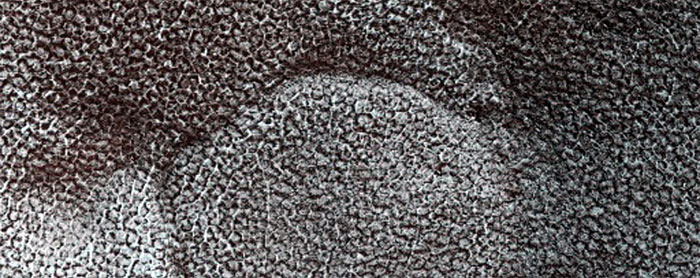
Southern Permafrost Survey

Mars is globally covered with permafrost, where soil temperatures are permanently below the freezing point of water. Bitter cold temperatures dominate the Martian equatorial regions, with an annual-mean temperature of the soil colder than -50 C, and colder still at middle and high latitudes. Therefore, any water present in the Martian soil or atop the soil surface must be in the form of ice. Icy-soil and surface-ice deposits influence the formation of Martian landforms, much as they do on Earth. Glacial deposits form characteristic flow features that indicate thick piles of water ice in a slow viscous motion, even when they are covered by dust and soil hiding the bright ice. Periglacial landforms are features found commonly on the margins of glaciers, where icy soil plays the most important role. Incredibly regular polygonal patterns, sorted stone circles and ridges, collapse pits and scalloped scarps, and smooth ice-cored mounds, commonly dot terrestrial landscapes. They form naturally as ice in the pore space between soil grains undergoes seasonal melting freezing cycles, or thermal expansion and contraction cycles. Early images of Mars from the Viking orbiters revealed a wide array of large scale features of a potentially glacial or periglacial origin at low resolution. Mars Global Surveyor provided greater details, but many of the diagnostic shapes and textures are typically only a meter in scale. HiRISE provides us with a new window to observe these features.
Major science questions for this theme.
What is the distribution of water ice in the Martian subsurface? The distribution of periglacial landforms allows us to globally map ice deposits. What is the history of surface ice deposits and the Martian climate? Climate cycles on Mars, similar to Earth's ice ages, could have resulted in glacial deposits, potentially anywhere on Mars in the past, thus relic landforms hint at the past, and at the history of water on Mars. Is ice accessible for future exploration? Some periglacial landforms reveal hidden ice in the subsurface that can be sampled and analyzed by future landed spacecraft or even future human explorers.
Relationship to other science themes.
The comings and goings of ice in the Martian environment relates to a wide range of landforms and other natural processes and nearly every other science theme. Melting of surface and subsurface ice deposits may lead to the formation of rivers and streams and other fluvial features if enough water is released to erode the surface. Likewise, evaporation of buried ice results in collapse, erosion, and general mass wasting of the surface. Water frosts come and go on Mars, an integral part of seasonal processes and the longer climate cycles that form glacial and periglacial features. The polar deposits of Mars comprise enormous glacial masses of ice. Volcanic flows can interact with ice to create special landforms through steam explosions and chilling fluid lavas.
Features of interest potentially visible at HiRISE scale.
Much of the middle and higher latitudes of Mars exhibit polygonal patterns tens of meters across, rather like a giant honeycomb exposed at the surface. Thermal contraction polygons are the most common periglacial feature on Earth, the results of seasonal cracking of ice-cemented soils. Polygon size, intersection angles, and trough depth are all clues to their origin and age. Such characteristics can distinguish permafrost polygonal patterns from other polygon-forming processes such as giant mud cracks or lava cooling cracks.
.
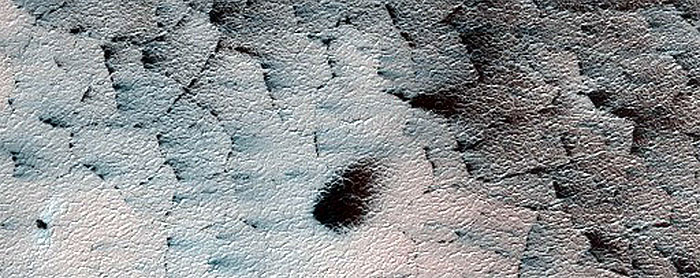
Active Fan Terrain on South Polar Cap

Mars' seasonal polar caps are composed primarily of carbon dioxide frost. This frost sublimates (changes from solid directly to gas) in the spring, boosting the pressure of Mars' thin atmosphere. In the fall the carbon dioxide condenses, causing the polar caps to reach as far as ~550 degrees latitude by late winter. In the study of seasonal processes we observe the caps as they wax and wane to investigate both large scale effects on Mars as well as the local details of the sublimation and condensation processes. By learning about current processes on a local level we can learn more about how to interpret the geological record of climate changes on Mars. Mars Observer Camera (MOC) images from the Mars Global Surveyor spacecraft have shown an astonishing array of exotic landscapes as the southern seasonal cap sublimates, including spots, "spiders", and fans. A region we plan to investigate near the south pole has been called the "cryptic" terrain because it seems to stay quite cold even after the disappearance of bright frost.
Major Science Questions for This Theme
What happens in the spring as the seasonal cap sublimes? What happens in the fall as frost condenses? What controls the extent of the seasonal polar cap each year? What controls the sublimation and condensation of the seasonal frost on a local level (topography, albedo of underlying terrain)? What is going on in the cryptic terrain at the southern polar cap? How do dust storms affect the local weather at the polar cap edge? What are the wind patterns and how do they change over the course of a season? Are geysers active as the caps sublimate? Is that what causes the spots and fans?
Relationship to Other Science Themes
This theme is closely related to the climate change and polar geology themes. Polar geology is primarily focused on the permanent polar deposits in contrast to this theme which is concerned with behavior of the seasonal cap. Climate change is an extension of seasonal processes in which we look for long-term trends that surpass seasonal variability.
Features of Interest Potentially Visible at HiRISE Scale
One example of many phenomena we would like to observe is the evolution of a "spot" to a "fan" as the seasonal cap retreats in the spring. Is a spot formed in a locally dark region that gets warmer faster than its surroundings, then grows? Is the darker material very fine and does it get blown across the surface of the brighter surrounding ice to form a fan? Or is the darker material lofted by Triton-like plumes such as those observed by Voyager 2? The high resolution and high signal-to-noise ratio of the HiRISE images along with stereo coverage will give us our best ever view of these unearthly terrains.
.
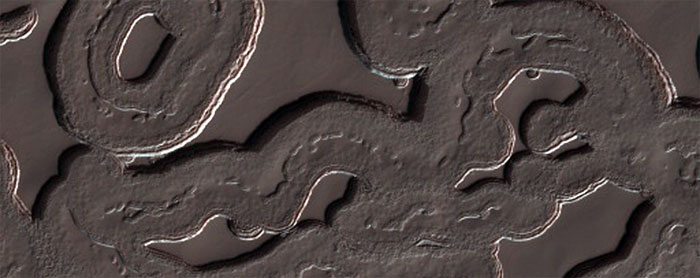
South Pole Residual Cap Monitoring

Mars has experienced climate change on many different timescales over its 4.5 billion year history. Cycles in its orbital eccentricity, obliquity and season of perihelion determine the solar insolation that affects where reservoirs of water and carbon dioxide will be stable (north pole vs. south pole vs. atmosphere vs. subsurface). This theme is focused on looking for current evidence of ongoing climate change. Past climates are addressed by the polar geology, fluvial processes and stratigraphy themes. Current climate change is detected by finding evidence that Mars' volatiles (H2O and CO2) are moving from one reservoir to another. Mars Observer Camera (MOC) data show this process underway for example in the "Swiss Cheese" terrain at Mars' south pole (see Figure 1). More CO2 is being eroded than is being replaced from year to year, which indicates that the CO2 reservoir at the south pole is not in equilibrium with Mars' current climate. MOC has been monitoring this change since 1999 by taking images of the same terrain every year. HiRISE will extend the MOC coverage into the future.
Major science questions for this theme
Is Mars experiencing global climate change right now?
Relationship to other science themes
This theme is closely related to the seasonal processes and polar geology themes. Polar geology is primarily focused on the permanent polar cap and the past climate record conserved in the polar layered deposits. Climate change is an extension of seasonal processes in which we look for long-term trends that surpass seasonal variability.
Features of interest potentially visible at HiRISE scale
One indicator that Mars may be currently experiencing global change is the evolution of the swiss cheese terrain. Other indicators such as formation of new gullies are covered by the fluvial processes theme.
.
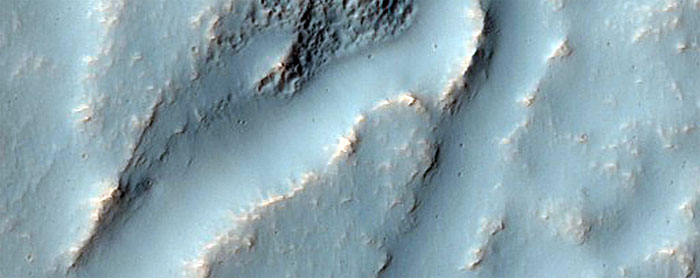
Small Valleys

A review of existing images of Mars reveals a diverse landscape. In some instances, such as around volcanoes and in valleys, a casual glance suggests the features are much like those here on Earth. Closer inspection, however, often confirms differences in scale and or subtle characteristics relative to their more familiar terrestrial counterparts.
These same images also reveal a Mars that is often very different form the Earth. Some locations are marked by huge jumbles of blocks forming chaotic terrain, whereas others are buried beneath blankets of dust. Bizarre “thumbprint,” “Swiss cheese,” and other surface textures also occur.
Current limits on the resolution of Mars images often preclude distinguishing the of processes responsible for shaping a landscape. The geomorphic thresholds that influence the efficiency and intensity of surface modification by different processes can often be hard to define. Indeed, different processes can sometimes produce very similar appearing landforms. Detecting the subtle, diagnostic signatures of past water erosion versus wind or other processes often requires the high resolution imagery that will be obtained by HiRISE. It is the analysis of HiRISE images that may provide some of the clues for a better understanding of the evolving Martian landscape.
.
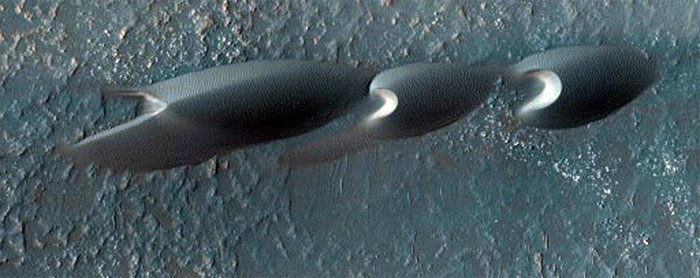
Barchan Dune Changes in Hellespontus Region

Aeolian geology is the study of landforms formed by wind (Aeolus is the wind god in Greek mythology). On Mars, where other processes such as fluvial erosion, volcanism, and tectonism are slow, intermittent, or do not occur in the present era, aeolian activity is the most dynamic geologic process in non-polar areas. Numerous depositional and erosional landforms attributable to wind activity are present. On a large scale seen from previous orbiters these include dunes, ripples, yardangs, wind tails, and dust devil tracks. At the small scale seen from landers and rovers, drifts, erosional moats, wind tails, ripples, and ventifacts are found. HiRISE, with its high resolution, color imaging, and ability to produce precise digital elevation models at small scales, should significantly advance our understanding of Martian aeolian processes, providing a link between features seen with older, lower resolution imaging systems and those observed at the landing site scale.
Major science questions for this theme
Do aeolian bedforms (dunes and ripples) migrate at the scales visible to HiRISE (< 1 m) over the period of the MRO mission (at least two Mars years)? In other words, are some dunes and ripples active or did they form in a different climate, when wind speeds may have been greater? If the bedforms are active, what is the rate of migration?
What are the origins and ages of bright vs. dark aeolian bedforms?
How rapidly does aeolian material infill topography and how does this vary over the planet?
What are the mechanisms and rates of removal of material by the wind and how does this vary with terrain age, lithology, and geology?
Relationship to other science themes
By their very nature, aeolian processes modify pre-existing surfaces, either through the redistribution and deposition of fines or the deflation or abrasion of material. In this sense, the aeolian theme crosses over all the other themes, leaving its imprint on all classes of Martian geology. Probably the greatest overlap is with the seasonal processes, climate change, and landscape evolution themes. Seasonal processes outside of the polar caps are predominantly aeolian, with global dust storms, dust devils, and wind streaks occurring on annual and smaller time scales. The wind speeds and sand loading that is possible in the present-day Martian climate seems insufficient to produce many of the observed aeolian landforms, such as dunes, megaripples, and yardangs, implying that past climatic regimes, when wind speeds may have been higher, are required. These aeolian processes integrated over time scales of many seasons and multiple climatic changes (probably driven by quasi-periodic variations in Mars orbital elements) have significantly contributed to landscape evolution through infilling of topographic lows, removal of topographic highs, and redistribution of material.
Features of interest potentially visible at HiRISE scale
The high resolution of HiRISE provides the ability to image and derive topography of features at meter and smaller scales, thereby helping to answer questions that could previously not be pursued with much confidence. We will be able to measure the height and spacing of dunes and ripples and monitor if the bedforms are moved by winds over the life of the MRO mission. Images of landslides on the brinks of dunes will provide information on the stability and lithification (via chemical cementation or ice) of sand. For yardangs, detailed morphometry from high resolution images and stereo DEMs may reveal notches, forms that on Earth are attributable to the height of peak abrasion by saltating sand. Fluting in mantled material seen at small scales should reveal the direction of winds that caused removal. Layering in yardang/mantled material seen by HiRISE will provide evidence on whether the material is of lacustrine (fine layers), volcanic (more massive), or some other origin.
.
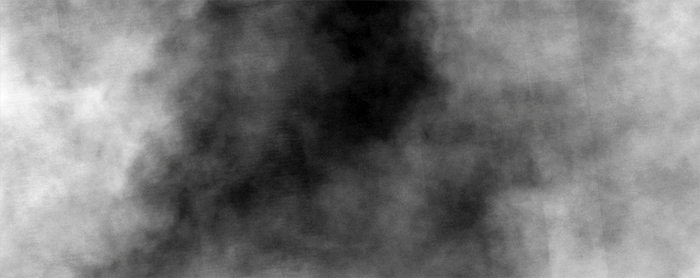
Candidate ExoMars Landing Site
.
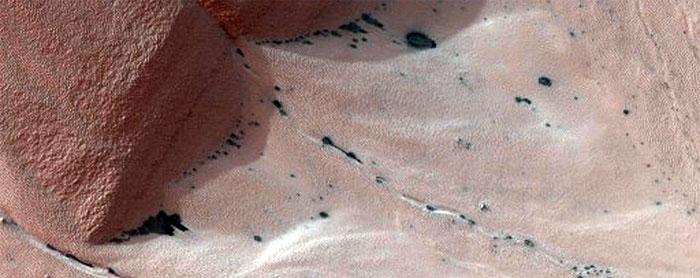
Gully Monitoring

"Mass wasting" is a geologic term that encompasses the rapid downhill movement of rocks and fine particles due to the force of gravity. One of the most common and generic types of mass wasting features on Earth are landslides, but there are many others such as rock falls, debris flows, soil creep, and debris avalanches.
Landslides or any other mass wasting feature, require some type of triggering mechanism to induce the movement of particles under gravity. Some of these mechanisms include volume expansion of fractures (i.e. cracks) in rocks by freeze/thaw processes, increase in soil pore pressure (i.e. water content), undermining or removal of less-resistant material below a stronger material layer, and strong vibrational forces produced from above (e.g., meteorite impact) or below ground (e.g., volcanic eruption, earthquake).
On Mars, two of the most common mass wasting features are landslides and dust avalanches (also referred to as slope streaks). Some of the most spectacular landslides in the solar system are found in the Valles Marineris canyon system on Mars and exhibit many of the classic characteristics of landslides on Earth. These characteristics include a semi-circular main scarp in the source region, a hummocky (i.e. irregular) or blocky surface in the upper portion of the deposit, surface ridges parallel to landslide flow direction in the middle portion of the deposit, and a lobate outer margin that has some significant thickness (e.g., tens to hundreds of meters). Dust avalanches are common on dune faces, crater interior walls, mesa slopes, and canyon scarps. The streaks are thought to occur when dust and/or other small particles on a sloped surface begins to move due to sublimation of a thin layer of water frost or by the over-steepening of slopes in localized dusty air fall deposits.
For more information about landslides on Earth, click here.
Major Science Questions for This Theme
What are the current and past rates for mass wasting in various terrains on Mars?
Do slope streaks involve water in their triggering and subsequent downslope movement?
What triggers large landslides (e.g., Marsquakes, tectonic oversteepening of slopes, fluvial and/or eolian undercutting of slopes, weakening of rock materials from hydrothermal, physical, or chemical weathering)?
Can one type of mass wasting feature be clearly distinguished from another on the basis of boulder frequency and distribution?
Features of Interest Potentially Visible at HiRISE Scale
Boulders: The sizes, shapes, sorting, colors, and distribution of boulders (~0.5 meters or larger in diameter) tell us a great deal about the transport process of mass wasting features. For slope streaks or other small mass wasting features, stereo coverage from HiRISE images may help resolve the topography or morphologies that are diagnostic of these processes.
Ridges: small ridges that can be seen in HiRISE images, but are too small or subtle to be seen in Mars Orbiter Camera (MOC) images, may be an indicator of a change in direction or rate of movement for landslide deposits or other larger mass wasting features. Faults—small offsets in the deposit layers such as along fractures or faults—may be an indicator compressional flow of materials in parts of the mass wasting feature.
.
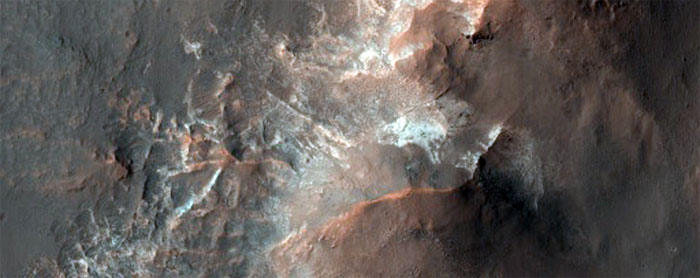
Mound with Light-Toned Slopes and Ridges at Base
.
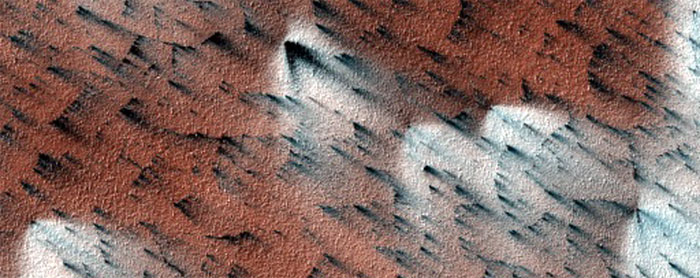
Fans and Polygons
.
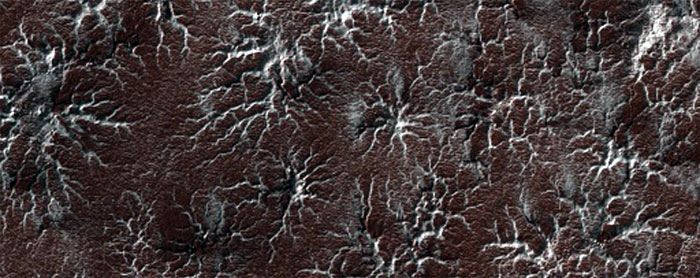
Spider Terrain
.
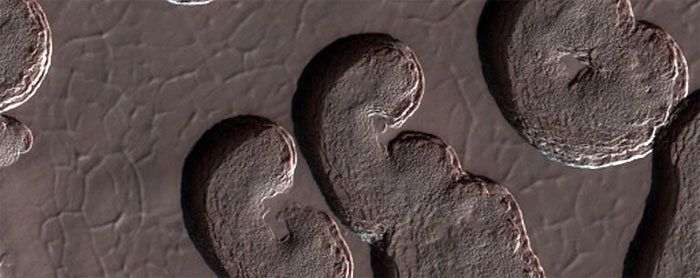
South Pole Residual Cap Yearly Monitoring
.
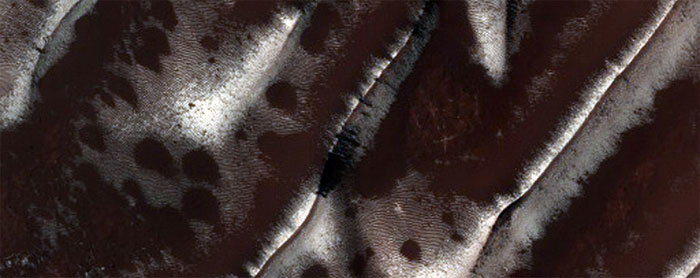
Monitor Defrosting South Mid-Latitude Dunes in Moc Image E05-00762
.

Polygons in Impact Crater
.
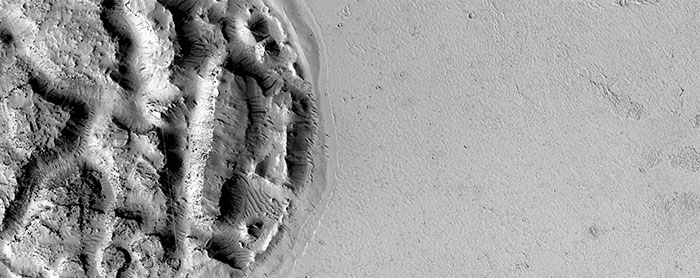
An Enigmatic Feature in Athabasca Lava Flows

Mars is fundamentally a volcanic planet. Geologic mapping of Mars shows that about half the surface seems to be covered with volcanic materials that have been modified to some extent by other processes (such as meteorite impacts, blowing wind, and floods of water). Mars has the largest volcanoes in the entire Solar System. The great volumes of erupted lava have had a profound impact on the entire planet, extracting heat and selected chemicals from within, adding large amounts of acidic gas to the atmosphere, and providing heat to melt frozen water in the crust. Mars cannot be understood without studying its volcanoes.
HiRISE provides the ideal tool to study some of the most puzzling aspects of Mars volcanism. One example is: what were the eruptions that formed the giant lava flows like? Did the lava ooze quietly out of the ground or did it come blasting up in massive explosions? Detailed pictures of the vents are essential for answering these questions.
We know that lava flows on Earth are usually fed by fountains or lakes of lava. HiRISE has already found examples of ancient lava lakes on Mars, but the evidence for fountains is more difficult to find. But we are finding exciting hints of cinder cones on Mars. The pictures from other cameras have been too fuzzy to show these kinds of details. Another high priority is to image places where both lava and water have come gushing from the ground. These are places where microbes that might live in the deep, warm, wet parts of the crust could have been brought to the surface. Finding scientifically interesting spots that are safe to land future rovers is one of the primary goals for the MRO mission.
.
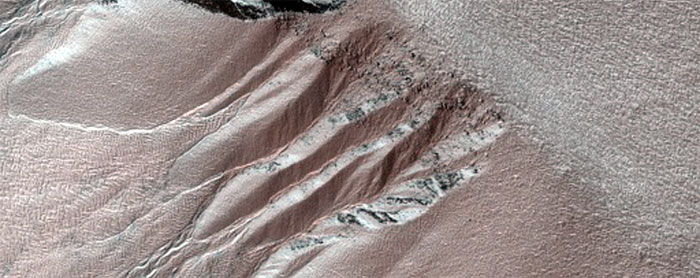
Gully Monitoring
.

South Pole Residual Cap Change Detection
.
Fotos: NASA
4690 Views
